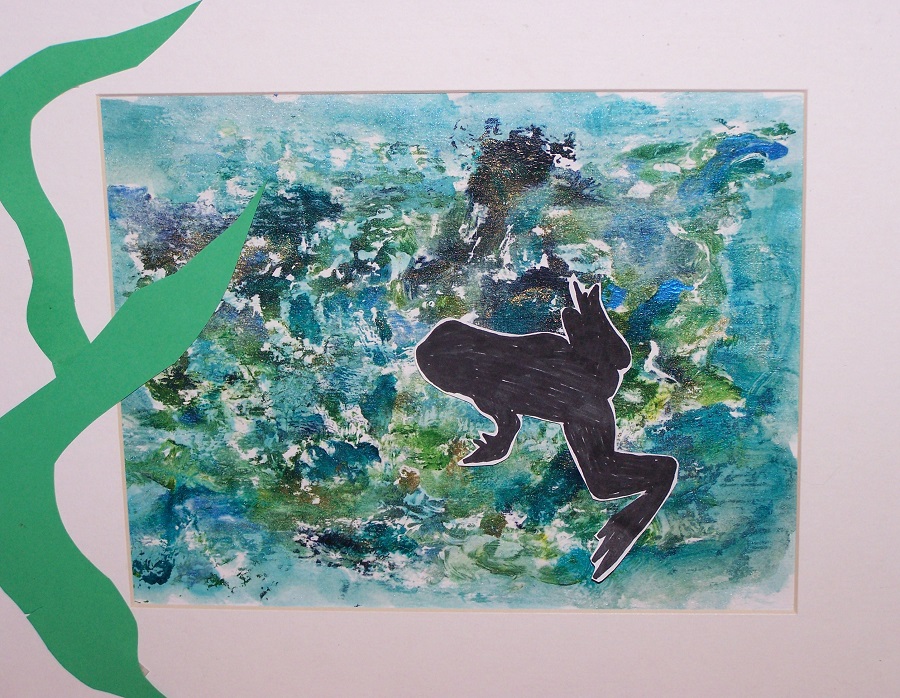
Textured salt painting with watered down tempera paint – Grade 1
Objective: To visually enhance any subject through texture and rich vocabulary
Ages: 5+
Time: 30-45 minutes
Grades: 1st +
Materials:
- Sand or salt
- White multi-media paper
- Construction paper
- Watercolor paints or watered down tempera paint
- Brushes
- Crayons
- Pencils (or fine tip markers
- Lined paper or index cards
- Glue
- Scissors
Lesson:
1. Choose your paper and select the topic and type of paint to be used. Depending upon the objective of your artwork, students can paint their picture with watercolor paint or watered down tempera paint.
2. Allow students to paint the entire picture or use crayon and paint combined.
3. Children can draw a picture with crayon, pressing firmly. Then add paint, creating a ‘crayon resist.’
4. Sprinkle salt or sand on the wet paint. Notice the textured look with both examples.
5. Let dry for 15-30 minutes, depending on type of paint you use.
6. Shake or gently rub salt/sand off and watch what appears. You may decide to leave the salt in order to create a more textured ‘feel’ to your painting.
7. Glue your painting to construction paper, creating a colorful border.
8. Use background knowledge to help drive your writing genre, allowing the children to use the textured visual to expand their rich vocabulary.
9. Place your writing on an index card or use lined paper and fine-tip marker to write across the finished painting. See “Other Ways to Use this Lesson” section below.
- Sand Texture
- Salt Texture
- 10 Minute Writing – Grade 2
Evaluation:
Allow the students to do a ‘gallery watch’ by raising their completed pictures above their heads to see each other’s work. Upon viewing the work, create an opportunity for your students to read orally, eliciting questions from their classmates. Depending upon your writing assignment, you can generate questions to be answered orally or in written application to assess comprehension. This is a great opportunity to move about the room and keep an on-going list of descriptive phrases as the kids discover new vocabulary. Whether you are assessing for descriptive writing or subject knowledge, it is imperative you let your students know your expectations.
Other Ways to Use this Lesson:
Kids need to be inspired by the use of visual imagery and texture. When we use texture, we enable kids to expand their vocabulary. Let them create their picture first and then the visual will drive their writing. You will be amazed at what happens when we accept visual imagery as a pre-writing step.
Don’t limit the ‘texture’… If the children want to use salt and sand, leave some texture or shake off the rest. When time is limited, use one texture and have the class respond with poetry or just a descriptive sentence. Move about the room and record the descriptive words they discover on the board or keep an on-going ‘new’ vocabulary list. Try sand art with pre-lined drawings. Perhaps the children can create 3 textured pictures for a beginning, middle and ending to enhance a narrative story. Additionally, try sand and real shells or pebbles. Remember, glitter paint will always add a sparkle.
Descriptive writing is great, especially when the kids can be inspired through wild life, sea life or natural habitats. Create a word frame using verbs, nouns or adjectives to drive your lesson; just list words around the edge of your visual, leaving room for a frame. You can easily use 3D dots and raise the textured picture or even raise 3-D pre-cut animal shapes out of paper, foam, felt or stencils, then add these visuals to your textured picture as a background. Now you have created a ‘layered’ look. This activity will certainly motivate your students to write expository paragraphs, poetry, and even riddles and facts. Have fun!
Search Terms: outdoors, environment, sand, salt, animal tracks, animals, zoo, insects, dinosaurs, butterflies, bugs, beach, sea life animals, rocky shore, aquarium, nature, rocks, stones, creative writing, narrative, expository, visual imagery, art, visualization, poetry, stencils, riddles, 3-D, habitats, wild life, trails, woods, forests, descriptive writing, vocabulary development, patterns, texture, trees, leaves, shells, gardens, flowers, birds, amphibians, reptiles, informational paragraphs, nouns, verbs, adjectives, Special Education (SPED), Learning Disabled, English language Learner (ELL), pre-cut animal shapes, foam, felt, stencils
About the Author:
 Kim Waltmire is a state and national award-winning educator. She holds an honorary seat with the 2006 USA Today All-Star Teacher team. Kim is a graduate from CCSU with a Masters in Early Childhood Education. She published a writing & literacy book; Picturesque Writing, now self-published as The Art of Visual Writing for elementary teachers K-5. Kim also published a Read-Along Series for primary grades, coupled with spelling, grammar, science and social studies lessons for k-12 with a home-school company. Her writing and Project Based Learning strategies were recognized and published in the Creative Classroom Teacher’s magazine; May/June 1998 issue. She was recognized for her educational contributions and Project Based Learning by Oprah Winfrey, interviewed on CNN, Fox News, and honored by the CT State Governor several times. Kim has taught elementary school for 28 years and presently an Educational Literacy Consultant. Kim’s passion is teaching writing literacy for all learning styles.
Kim Waltmire is a state and national award-winning educator. She holds an honorary seat with the 2006 USA Today All-Star Teacher team. Kim is a graduate from CCSU with a Masters in Early Childhood Education. She published a writing & literacy book; Picturesque Writing, now self-published as The Art of Visual Writing for elementary teachers K-5. Kim also published a Read-Along Series for primary grades, coupled with spelling, grammar, science and social studies lessons for k-12 with a home-school company. Her writing and Project Based Learning strategies were recognized and published in the Creative Classroom Teacher’s magazine; May/June 1998 issue. She was recognized for her educational contributions and Project Based Learning by Oprah Winfrey, interviewed on CNN, Fox News, and honored by the CT State Governor several times. Kim has taught elementary school for 28 years and presently an Educational Literacy Consultant. Kim’s passion is teaching writing literacy for all learning styles.
- Twitter: @kwaltmire
- LinkedIn: www.linkedin.com/in/kimwaltmire/
- Website: www.visualccl.com










